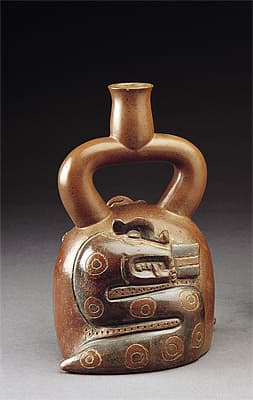
CUPISNIQUE culture North coast 1000 BC – 200 BC
Stirrup vessel with snakes 1000-200 BC ceramic21.1 (h) x 12.2 (w) x 15.2 (d) cm Museo Larco, Lima Photograph: Museo Larco
The Cupisnique Valley is located in the north of Peru, near modern Chicama. The culture flourished there between its beginnings from about 1000 to about 200 BC, in the region where the Moche arose shortly after the Cupisnique disappeared. Contemporary with the Chavín culture, Cupisnique was identified as a separate style by Rafael Larco Hoyle in 1929, and is now regarded as a discrete, rather than a Chavinoid, phenomenon. Several northern coastal and inland cultures existed at this time and seem to have interacted with each other, possibly trading as much in religious ideas as in goods.
The vessel, used for ceremonies, has the stirrup spout with slightly flared tip characterististic of Cupisnique ceramics. It was made of red clay, with modelled relief elements and incised circles. Red pigments were probably applied in a slip before firing. A final coat of darker graphite slip ‘made from a low-grade coal, must be applied after initial firing to prevent it from being burnt off’.1 The subject, depicted on both sides, is a snake with a fanged feline mouth. Mystical transformation was central to Cupisnique religious ideas, and shamans used mescaline from the San Pedro cactus for its psychotropic qualities.2 Lethal snakes and powerful jaguars were depicted often in art, because those qualities of ruthlessness and strength were identified as essential characteristics by priests and rulers throughout the Andean world.
Christine Dixon
1. Richard L. Burger in Kathleen Berrin (ed.), The spirit of ancient Peru: Treasures from the Museo Arqueológico Rafael Larco Herrera, New York: Thames and Hudson 1997, cat. 4, p. 76. 2. Richard L. Burger, Chavin and the origins of Andean civilization, London: Thames and Hudson 1992, p. 96.
The Cupisnique Valley is located in the north of Peru, near modern Chicama. The culture flourished there between its beginnings from about 1000 to about 200 BC, in the region where the Moche arose shortly after the Cupisnique disappeared. Contemporary with the Chavín culture, Cupisnique was identified as a separate style by Rafael Larco Hoyle in 1929, and is now regarded as a discrete, rather than a Chavinoid, phenomenon. Several northern coastal and inland cultures existed at this time and seem to have interacted with each other, possibly trading as much in religious ideas as in goods.
The vessel, used for ceremonies, has the stirrup spout with slightly flared tip characterististic of Cupisnique ceramics. It was made of red clay, with modelled relief elements and incised circles. Red pigments were probably applied in a slip before firing. A final coat of darker graphite slip ‘made from a low-grade coal, must be applied after initial firing to prevent it from being burnt off’.1 The subject, depicted on both sides, is a snake with a fanged feline mouth. Mystical transformation was central to Cupisnique religious ideas, and shamans used mescaline from the San Pedro cactus for its psychotropic qualities.2 Lethal snakes and powerful jaguars were depicted often in art, because those qualities of ruthlessness and strength were identified as essential characteristics by priests and rulers throughout the Andean world.
Christine Dixon
1. Richard L. Burger in Kathleen Berrin (ed.), The spirit of ancient Peru: Treasures from the Museo Arqueológico Rafael Larco Herrera, New York: Thames and Hudson 1997, cat. 4, p. 76. 2. Richard L. Burger, Chavin and the origins of Andean civilization, London: Thames and Hudson 1992, p. 96.
The Cupisnique Valley is located in the north of Peru, near modern Chicama. The culture flourished there between its beginnings from about 1000 to about 200 BC, in the region where the Moche arose shortly after the Cupisnique disappeared. Contemporary with the Chavín culture, Cupisnique was identified as a separate style by Rafael Larco Hoyle in 1929, and is now regarded as a discrete, rather than a Chavinoid, phenomenon. Several northern coastal and inland cultures existed at this time and seem to have interacted with each other, possibly trading as much in religious ideas as in goods.
The vessel, used for ceremonies, has the stirrup spout with slightly flared tip characterististic of Cupisnique ceramics. It was made of red clay, with modelled relief elements and incised circles. Red pigments were probably applied in a slip before firing. A final coat of darker graphite slip ‘made from a low-grade coal, must be applied after initial firing to prevent it from being burnt off’.1 The subject, depicted on both sides, is a snake with a fanged feline mouth. Mystical transformation was central to Cupisnique religious ideas, and shamans used mescaline from the San Pedro cactus for its psychotropic qualities.2 Lethal snakes and powerful jaguars were depicted often in art, because those qualities of ruthlessness and strength were identified as essential characteristics by priests and rulers throughout the Andean world.
Christine Dixon
1. Richard L. Burger in Kathleen Berrin (ed.), The spirit of ancient Peru: Treasures from the Museo Arqueológico Rafael Larco Herrera, New York: Thames and Hudson 1997, cat. 4, p. 76. 2. Richard L. Burger, Chavin and the origins of Andean civilization, London: Thames and Hudson 1992, p. 96.

